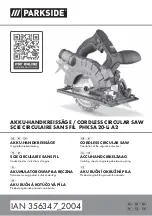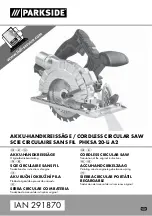
1
OPERATION
18
AUXILIARY WOOD FENCE (FIG. OO)
When making multiple or repetitive cuts that result in cut-off
pieces of one inch or less, it is possible for the saw blade to
catch the cut-off piece and throw it out of the saw or into the
blade guard and housing, possibly causing damage or injury.
To minimize this, an auxiliary wood fence can be mounted to
your saw.
Holes
are provided in the saw fence to attach an auxiliary
wood fence. This fence is to be constructed of straight wood
approximately 3/4 in. thick by 2-1/2 in. high by 18 in. long.
Attach the wood fence securely and make a full depth cut to
make a blade slot.
Check
for interference between the wood fence and the
lower blade guard. Adjust if necessary.
NOTE: This auxiliary fence is used only with the saw blade
in the 0° bevel position (90° to the table). The auxiliary wood
fence must be removed when bevel cutting.
Blade slot
Fig. OO
CUTTING BASE MOLDING (FIG. PP)
Base moldings and many other moldings can be cut on a com
-
pound miter saw. The setup of the saw depends on molding
characteristics and applications, as shown. Perform practice
cuts on scrap material. To achieve best results:
1. Always make sure moldings rest firmly against fence and
table. Use hold-down or C-clamps, whenever possible,
and place tape on the area being clamped to avoid marks.
2. Reduce splintering by taping the cut area prior to making
cut. Mark cut line directly on the tape.
3. Splintering typically happens due to wrong blade
application and thinness of the material.
Fig. PP
Miter saw table
Miter at 45°, bevel at 0°
F
e
n
c
e
Workpiece
Miter saw table
F
e
n
c
e
Workpiece
Miter at 0°, bevel at 45°
NOTE: Always perform a dry run cut so you can determine
if the operation being attempted is possible before power is
applied to the saw.
CUTTING CROWN MOLDING (FIG. QQ, RR)
Your
compound miter saw is suited for the difficult task of cut
-
ting crown molding. To fit properly, crown molding must be
compoundmitered with extreme accuracy. The two surfaces on
a piece of crown molding that fit flat against the ceiling and wall
are at angles that,
when added together, equal exactly 90¡ .
most
crown molding has a top rear angle (the section that fits
flat against the ceiling) of 52° and a bottom rear angle (the
section that fits flat against the wall) of 38°.
In order to accurately cut crown molding for a
90¡ inside or
outside corner,
lay the molding with its broad back surface
flat on the saw table.
When setting the bevel and miter angles for compound miters,
remember that the settings are interdependent – changing
one changes the other, as well.
CUTTING BOWED MATERIAL (FIG. MM)
NOTE: Hold-down clamp is optional.
A bowed workpiece must be
positioned against the fence and
secured with a clamp (1)
before cutting as shown.
Do not position
workpiece
incorrectly or
try to cut the
workpiece
without the
support of the fence.
This will cause the blade
to bind and could result
in personal injury.
1
2
3
WORKPIECE SUPPORT AND REPETITIVE CUTTING
USING THE STOP PLATE (FIG. NN)
NOTE: Hold-down clamp is optional.
Long pieces need extension table support.
1. Loosen the knob (1) then slide the extension table to
desired position and tighten the knob.
2. The
stop
plate is
designed
for use during
repetitive cutting.
Only use one stop
plate at a time.
Loosen the locking
bolt (2), rotate the
stop plate (3) to
vertical position
and retighten the
locking bolt.
Fig. MM
Fig. NN
Содержание KN M-2502N
Страница 53: ...www knova com mx...
















































